Characteristics of Lithium Deposits in Mongolia
Abstract
1. Introduction
2. Lithium Deposit Types
2.1. Granite–Pegmatite-Related Lithium Deposits
2.2. Lithium Clay Deposits (Sedimentary Rocks Hosted Lithium Deposits)
2.3. Lithium Brine Deposits
3. Lithium Mineralization in Mongolia
3.1. Granite–Pegmatite-Related Lithium Deposits
3.1.1. Lithium Pegmatite
3.1.2. Lithium–Fluorine Granites
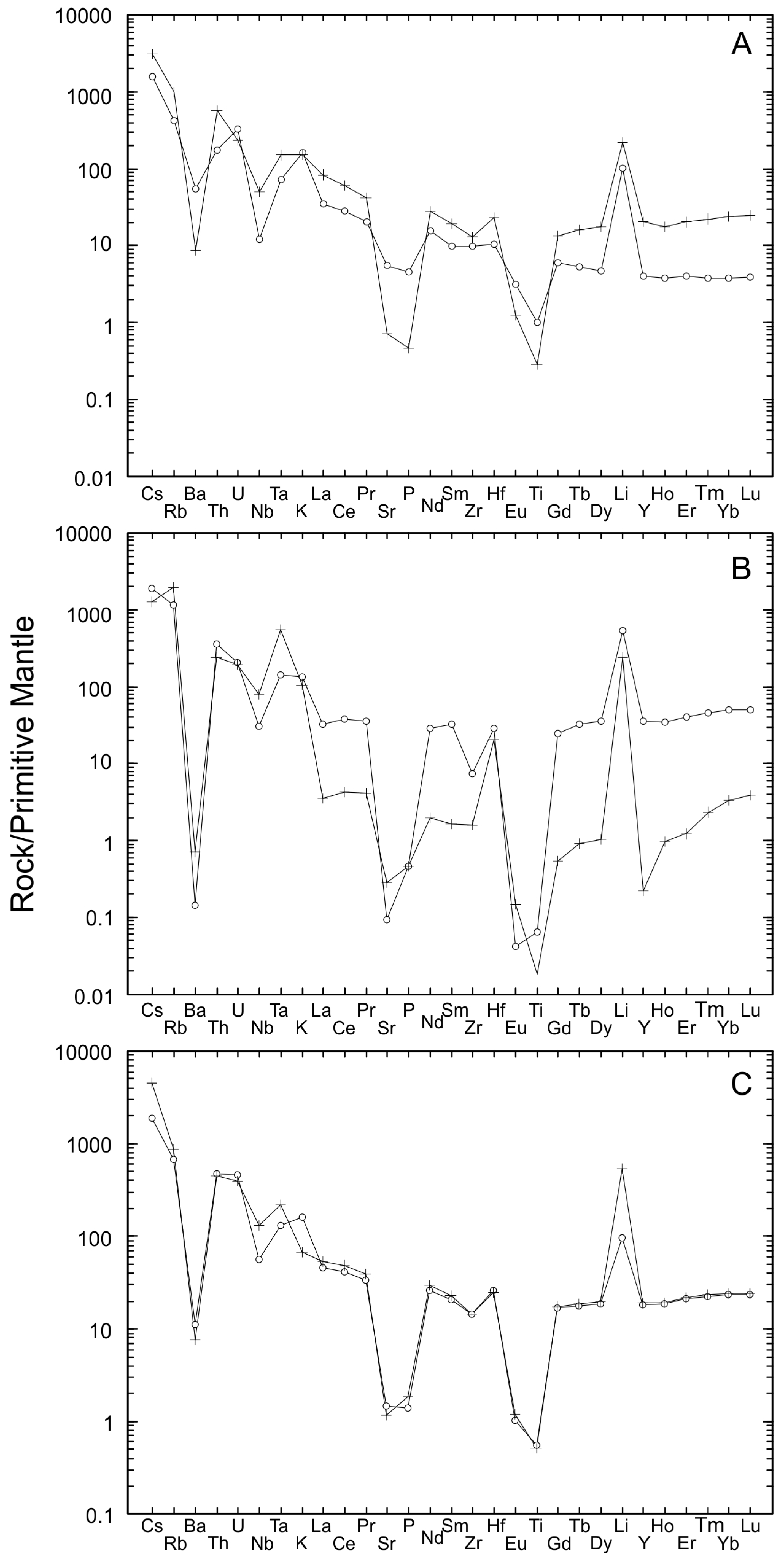
3.1.3. Li-F Subvolcanic and Volcanic Felsic Rocks (Ongonites and Ongorhyolites)
3.2. Sedimentary Rocks Hosted Lithium Deposits
3.3. Lithium-Bearing Brines
4. Conclusions
Supplementary Materials
Author Contributions
Funding
Data Availability Statement
Conflicts of Interest
References
- Grew, E.S. The minerals of lithium. Elements 2020, 16, 235–240. [Google Scholar] [CrossRef]
- Brooks, K. Lithium minerals. Geol. Today 2020, 36, 192–197. [Google Scholar] [CrossRef]
- Bowell, R.J.; Lagos, L.; de los Hoyos, C.; Declercq, J. Classification and characteristics of natural lithium resources. Elements 2020, 16, 259–264. [Google Scholar] [CrossRef]
- Stanley, C.; Jones, G.C.; Rumsey, M.S.; Blake, C.; Roberts, A.C.; Stirling, J.A.R.; Carpenter, G.J.C.; Whitfield, P.S.; Grice, J.D.; Lepage, Y. Jadarite, LiNaSiB3O7(OH), a new mineral species from the Jadar Basin, Serbia. Eur. J. Mineral. 2007, 19, 575–580. [Google Scholar] [CrossRef]
- Gourcerol, B.; Gloaguen, E.; Melleton, J.; Tuduri, J.; Galiegue, X. Re-assessing the European lithium resource potential—A review of hard-rock resources and metallogeny. Ore Geol. Rev. 2019, 109, 494–519. [Google Scholar] [CrossRef]
- U.S. Geological Survey. Mineral Commodity Summaries 2019; U.S. Geological Survey: Reston, VA, USA, 2019; pp. 98–99. [Google Scholar]
- Láznička, P. Giant Metallic Deposits; Springer: Berlin, Germany, 2006; 732p. [Google Scholar]
- London, D. Ore-forming processes within granitic pegmatites. Ore Geol. Rev. 2018, 101, 349–383. [Google Scholar] [CrossRef]
- Černý, P.; Ercit, T.S. The classification of granitic pegmatites revisited. Can. Mineral. 2005, 43, 2005–2026. [Google Scholar] [CrossRef]
- Gerel, O. Rare Metals: Tin, Tungsten, Molybdenum, Lithium, Tantalum and Niobium Deposits. In Mineral Resources of Mongolia; Gerel, O., Pirajno, F., Batkhishig, B., Dostal, J., Eds.; Modern Approaches in Solid Earth Sciences; Springer: Singapore, 2021; pp. 129–184. [Google Scholar]
- Černy, P.; Blevin, P.L.; Cuney, M.; London, D. Granite-related ore deposits. Econ. Geol. 2005, 100, 337–370. [Google Scholar]
- Dostal, J. Rare Earth Element Deposits of Alkaline Igneous Rocks. Resources 2017, 6, 34. [Google Scholar] [CrossRef]
- Evans, K. Lithium. In Critical Metals Handbook; Gunn, G., Ed.; American Geophysical Union: Washington, DC, USA, 2014; pp. 230–260. [Google Scholar]
- U.S. Geological Survey. Minerals Yearbook 2015; Mineral Industry of Serbia: Boulder, CO, USA, 2015; 36p. [Google Scholar]
- Kharaka, Y.K.; Hanor, J.S. Deep fluids in the continents: I. Sedimentary basins. In Surface and Ground Water, Weathering, and Soils. Treatise on Geochemistry 5; Drever, J.I., Ed.; Elsevier: Amsterdam, The Netherlands, 2003; pp. 1–48. [Google Scholar]
- Kesler, S.E.; Gruber, P.W.; Medina, P.A.; Keoleian, G.A.; Everson, M.P.; Wallington, T.J. Global lithium resources: Relative importance of pegmatite, brine and other deposits. Ore Geol. Rev. 2012, 48, 55–69. [Google Scholar] [CrossRef]
- Collins, A.G. Lithium abundances in oilfield waters. In Lithium Resources and Requirements by the Year 2000; Vine, J.D., Ed.; US Geological Survey Professional Paper; Boulder, CO, USA, 1976; Volume 1005, pp. 116–123. Available online: https://pubs.usgs.gov/pp/1005/report.pdf (accessed on 18 June 2020).
- Thompson, J.M.; Fournier, R.O. Chemistry and geothermometry of brine produced from the Salton Sea scientific drill hole, Imperial Valley, California. J. Geophys. Res. Solid Earth 1988, 93, 13165–13173. [Google Scholar] [CrossRef]
- Kovalenko, V.I.; Kuzmin, M.I.; Zonenshain, L.P.; Nagibina, M.S.; Pavlenko, A.S.; Vladykin, N.V.; Tseden, T.; Gundsambuu, T.; Goreglyad, A.V. Rare-Metal Granitoids in Mongolia: Petrology, Distribution of Rare Elements and Origin; Nauka: Moscow, Russia, 1971; 225p. (In Russian) [Google Scholar]
- Tauson, L.V. The Geochemical Types of Granitoids and Their Potential Ore Capacity; Nauka: Moscow, Russia, 1977; 280p. (In Russian) [Google Scholar]
- Beus, A.A.; Severov, V.A.; Citnin, A.A.; Cubbotin, K.D. Albitizated and Greisenizated Granites (Apogranites); Academy of Sciences of USSR: Moscow, Russia, 1962; 196p. (In Russian) [Google Scholar]
- Kovalenko, V.I.; Kuzmin, M.I.; Antipin, V.S.; Petrov, I.I. Topaz-bearing quartz keratophyre (ongonite): A new variety of subvolcanic igneous dike rocks. Dokl. Akad. Nauk SSSR Earth Sci. Sect. 1971, 199, 132–135. [Google Scholar]
- Kovalenko, V.I.; Kovalenko, N.I. Ongonites-subvolcanic analogues of rare metal lithium-fluorine granites. In Joint Soviet-Mongolian Scientific-Research Geological Expedition. Transaction 15; Nauka: Moscow, Russia, 1976; 128p. (In Russian) [Google Scholar]
- Vladykin, N.V.; Dorfman, M.D.; Kovalenko, V.I. Mineralogy, geochemistry and origin of rare metal topaz-lepidolite-albite pegmatites in Mongolian People’s Republic. Proc. Fersman Mineral. Mus. 1974, 23, 6–49. (In Russian) [Google Scholar]
- Kuznetsova, L.G.; Spiridonov, A.M.; Dril, S.I.; Kulikova, Z.I. Geochemistry of lepidolitic granitoids from the Mungutiyn Tsagaan Durulj occurrence (central Mongolia). Russ. Geol. Geophys. 2012, 53, 1077–1089. [Google Scholar] [CrossRef]
- Mineral Resources and Petroleum Authority of Mongolia. The Annual Report 2016. Ulaanbaatar. Available online: https://www.mrpam.gov.mn/public/pages/66/MPRAMreport2016EN.pdf (accessed on 18 June 2020).
- Tunnell, B.N.; Dashtseren, K.; Boldbaatar, E.; Locmelis, M.; Yang, Y.; Nakano, N.; Adachi, T.; Hames, W.; Arribas, A. Genesis and geochronology of the Bayanteeg LCT pegmatite in the Idermeg terrane, Central Mongolia. In Proceedings of the Goldschmidt Conference, Chicago, IL, USA, 18–23 August 2024. Paper 23849. [Google Scholar]
- Dashtseren, K.; Tunnell, B.N.; Boldbaatar, E.; Locmelis, M.; Yang, Y.; Nakano, N.; Adachi, T.; Hames, W.; Arribas, A. Geochronology of the LCT pegmatites in Central Mongolia. In Proceedings of the Goldschmidt Conference, Chicago, IL, USA, 18–23 August 2024; Paper 23340, poster#168. [Google Scholar]
- Gerel, O.; Kanisawa, S.; Ishikawa, K. Petrological characteristics of granites from the Avdrant and Janchivlan plutons, Khentei Range, Central Mongolia. Probl. Geodyn. Metallog. Mongolia. Trans. 1999, 13, 34–39. [Google Scholar]
- Antipin, V.S.; Gerel, O.; Perepelov, A.; Odgerel, D.; Zolboo, T. Late Paleozoic and Early Mesozoic rare-metal granites in Central Mongolia and Baikal region: Review of geochemistry, possible magma sources and related mineralization. J. Geosci. 2016, 61, 105–125. [Google Scholar] [CrossRef]
- Dostal, J.; Gerel, O. Occurrences of Niobium and Tantalum Mineralization in Mongolia. Minerals 2022, 12, 1529. [Google Scholar] [CrossRef]
- Machowiak, K.; Stawikowski, W.; Achramowicz, S. Late Triassic 40Ar–39Ar ages of the Baga–Gazryn Chuluu granites (Central Mongolia). J. Geosci. 2012, 57, 173–188. [Google Scholar] [CrossRef][Green Version]
- Antipin, V.S.; Kuzmin, M.I.; Odgerel, D.; Kushch, L.V.; Sheptyakova, N.V. Rare-metal Li-F granites in the Late Paleozoic, Early Mesozoic, and Late Mesozoic magmatic areas of Central Asia. Russ. Geol. Geophys. 2022, 63, 772–788. [Google Scholar] [CrossRef]
- Antipin, V.S.; Kushch, L.V.; Odgerel, D.; Belozerova, O.Y. Early Mesozoic rare-metal granites and metasomatites of Mongolia: Mineral and geochemical features and hosted ore mineralization (Baga Gazriin Chuluu pluton). Russ. Geol. Geophys. 2021, 62, 1061–1073. [Google Scholar] [CrossRef]
- Antipin, V.S.; Odgerel, D. Abdar-Khoshutula intrusive-dike series: Evolution and origin of granitoids in Early Mesozoic magmatic area (Central Mongolia). Petrology 2016, 24, 497–511. [Google Scholar] [CrossRef]
- McDonough, W.F.; Sun, S.-S. The composition of the Earth. Chem. Geol. 1995, 120, 229–253. [Google Scholar] [CrossRef]
- London, D.; Morgan, C.B.; Hervig, R.I. Vapour-undersaturated experiments with Macusani glass + H2O at 200 MPa, and their internal differentiation of granitic pegmatites. Contrib. Mineral. Petrol. 1989, 102, 1–17. [Google Scholar] [CrossRef]
- Pichavant, M.; Kontak, D.J.; Herrera, J.V.; Clarke, A.H. The Miocene–Pliocene Macusani volcanics, SE Peru, I. Mineralogy and magmatic evolution of two-mica aluminosilicate-bearing ignimbrite suite. Contrib. Mineral. Petrol. 1988, 100, 300–324. [Google Scholar] [CrossRef]
- Pichavant, M.; Kontak, D.J.; Herrera, J.V.; Clarke, A.H. The Miocene–Pliocene Macusani volcanics, SE Peru, II. Geochemistry and origin of a felsic peraluminous magma. Contrib. Mineral. Petrol. 1988, 100, 325–338. [Google Scholar] [CrossRef]
- Dostal, J.; Kontak, D.J.; Gerel, O.; Shellnutt, J.G.; Fayek, M. Cretaceous ongonites (topaz-bearing albite-rich microleucogranites) from Ongon Khairkhan, Central Mongolia: Products of extreme magmatic fractionation and pervasive metasomatic fluid: Rock interaction. Lithos 2015, 236, 173–189. [Google Scholar] [CrossRef]
- Štemprok, M. Ongonite from Ongon Khairkhan, Mongolia. Mineral. Petrol. 1991, 43, 253–273. [Google Scholar] [CrossRef]
- Dostal, J.; Chatterjee, A.K. Origin of topaz-bearing and related peraluminous granite of the Late Devonian Davis Lake Pluton, Nova Scotia, Canada: Crystal versus fluid fractionation. Chem. Geol. 1995, 123, 67–88. [Google Scholar] [CrossRef]
- Dostal, J.; Chatterjee, A.K. Contrasting behaviour of Nb/Ta and Zr/Hf ratios in a peraluminous granitic pluton (Nova Scotia, Canada). Chem. Geol. 2000, 163, 207–218. [Google Scholar] [CrossRef]
- Ballouard, C.; Poujol, M.; Boulvais, P.; Branquet, Y.; Tarese, R.; Vineresse, J.L. Nb-Ta fractionation in peraluminous granites: A marker of the magmatic-hydrothermal transition. Geology 2016, 44, 231–234. [Google Scholar] [CrossRef]
- Michaud, J.A.; Pichavant, M.; Villaros, A. Rare elements enrichment in crustal peraluminous magmas: Insights from partial melting experiments. Contrib. Mineral. Petrol. 2021, 176, 96. [Google Scholar] [CrossRef]
- Meng, Q.-R.; Hu, J.-M.; Jin, J.-Q.; Zhang, Y.; Xu, D.-F. Tectonics of the late Mesozoic wide extensional basin system in the China-Mongolia border region. Basin Res. 2003, 15, 397–415. [Google Scholar] [CrossRef]
- Chuluun, O.; Odontuya, O. Geology, structure and ore mineralization of the Khukh Del sedimentary lithium deposit. In Geology, Mineralogy and Metallogeny of Mongolia’ore Deposits; MUST Printing House: Ulaanbaatar, Mongolia, 2017; 62p. [Google Scholar]
- Ariunbileg, S.; Isupov, V.P.; Vladimirov, A.G.; Krivonogov, S.K.; Shatskaya, S.S. Trace element contents of mineralize lakes in Eastern Mongolia. Mong. Geosci. 2009, 35, 115–116. [Google Scholar]
- Ion Energy TSX-V. Exploring and Developing Mongolia’s Lithium Salars. Available online: https://www.ionenergy.ca (accessed on 17 July 2024).
- Linhoff, B.S.; Bennett, P.C.; Tamir, P.; Gerel, O. Geochemical evolution of uraniferous soda lakes in Eastern Mongolia. Environ. Earth Sci. 2010, 62, 171–183. [Google Scholar] [CrossRef]
- Isupov, V.P.; Vladimirov, A.; Ariunbileg, S.; Kolpakova, M.; Shvartsev, S.; Volkova, N. Hydromineral resources of saline lakes of Mongolia and Russian Altai. Adv. Miner. Res. 2015, 1085, 166–170. [Google Scholar] [CrossRef]
- Ariunbileg, S.; Isupov, V.P.; Vladimirov, A.G.; Orkhonselenge, A.; Shatskaya, S.S. Impact of climate change on hydrogeochemical characteristics of lakes in the Valley of Lakes, southern Mongolia. In Proceedings of the Goldschmidt Conference, Paris, France, 13–18 August 2017; Presentation #2169. [Google Scholar]
- Boehnke, P.; Watson, E.B.; Trail, D.; Harrison, T.M.; Schmitt, A.K. Zircon saturation revisited. Chem. Geol. 2013, 351, 324–334. [Google Scholar] [CrossRef]
- Watson, E.B.; Harrison, T.M. Zircon saturation revisited: Temperature and composition effects in a variety of crustal magma types. Earth Planet. Sci. Lett. 1983, 64, 295–304. [Google Scholar] [CrossRef]
- Harrison, T.M.; Watson, E.B. The behavior of apatite during crustal anatexis: Equilibrium and kinetic considerations. Geochim. Et Cosmochim. Acta 1984, 48, 1467–1477. [Google Scholar] [CrossRef]
- Montel, J.M. A model for monazite/melt equilibrium and application to the generation of granitic magmas. Chem. Geol. 1993, 110, 127–146. [Google Scholar] [CrossRef]



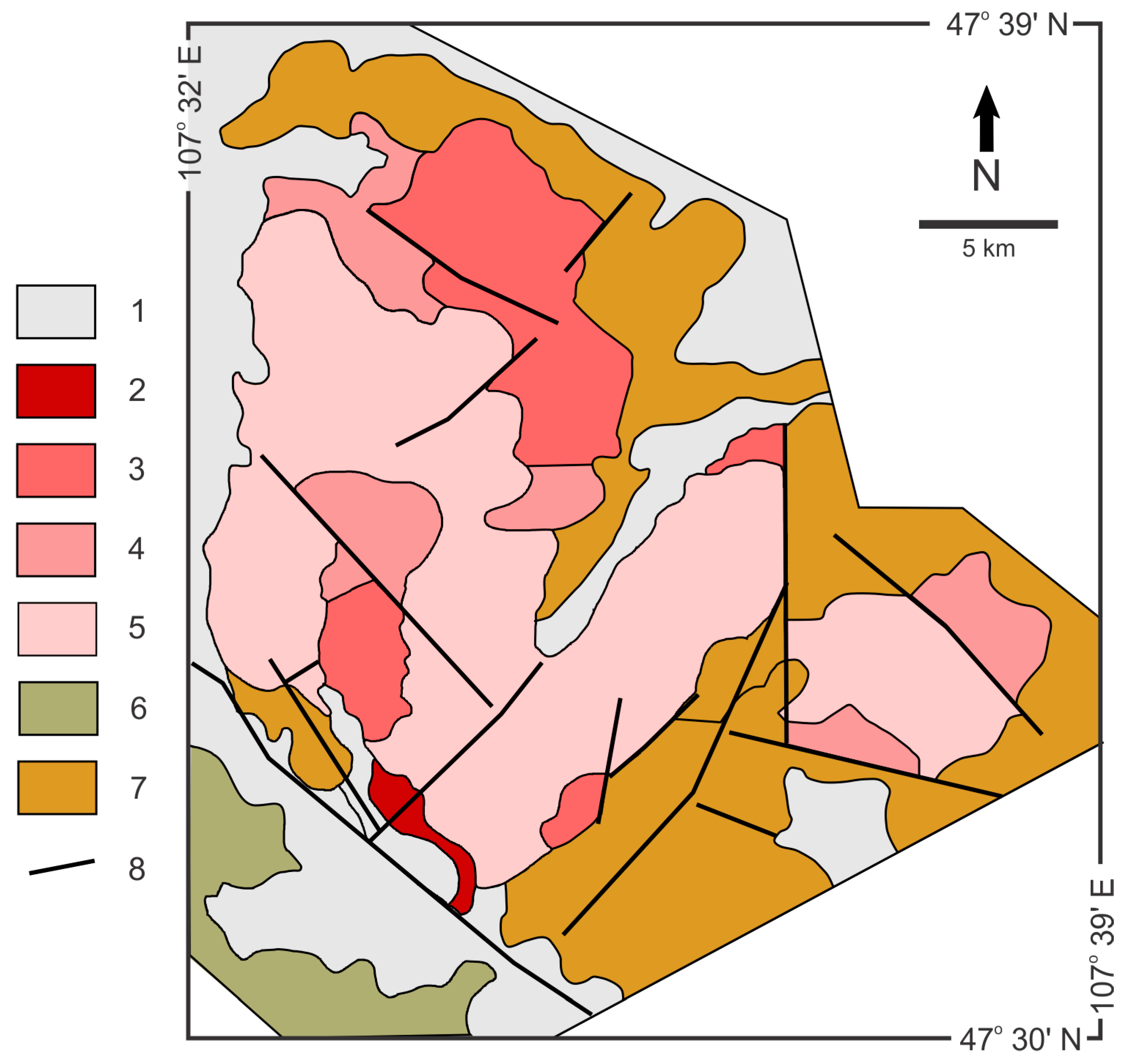
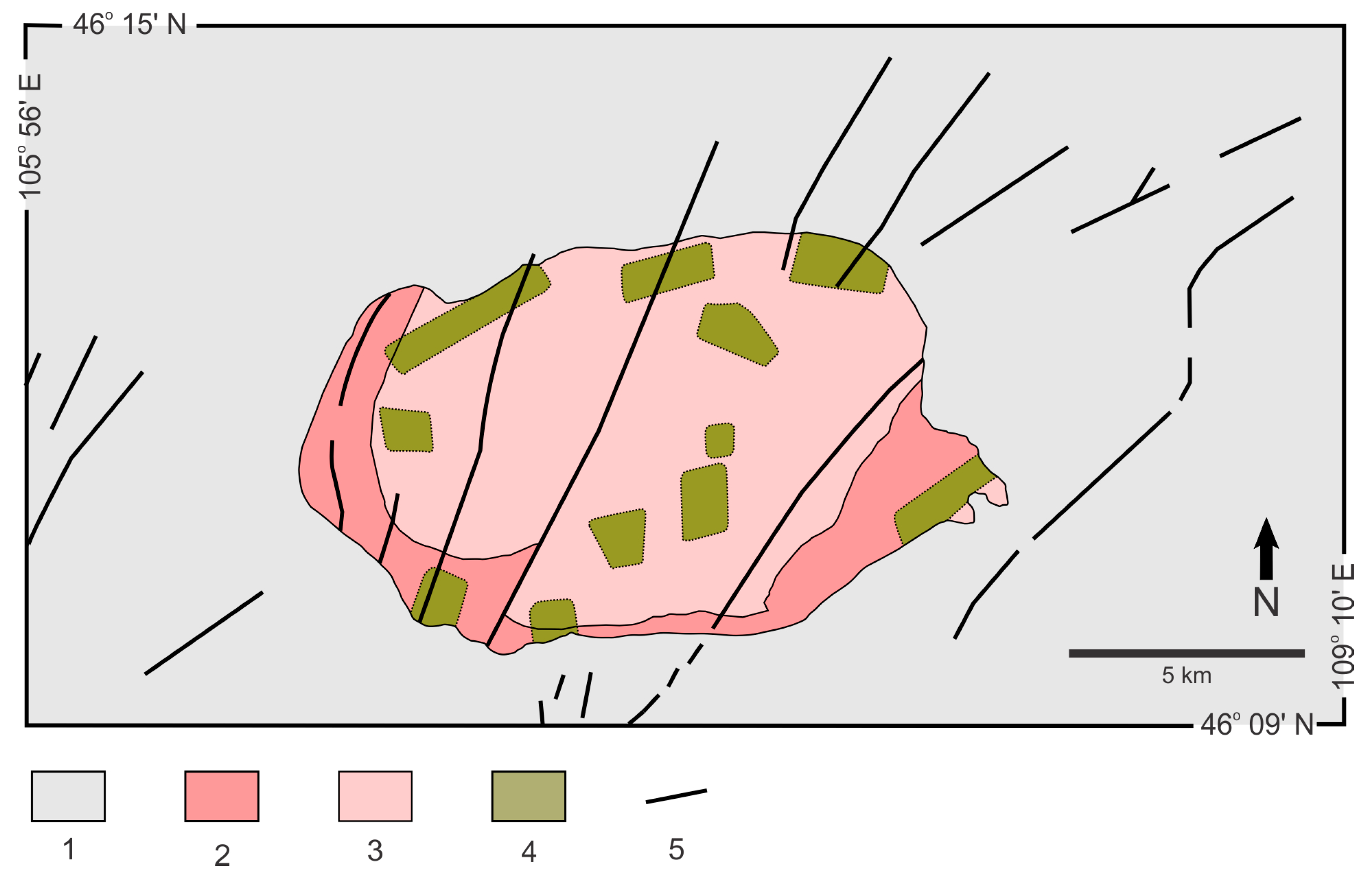
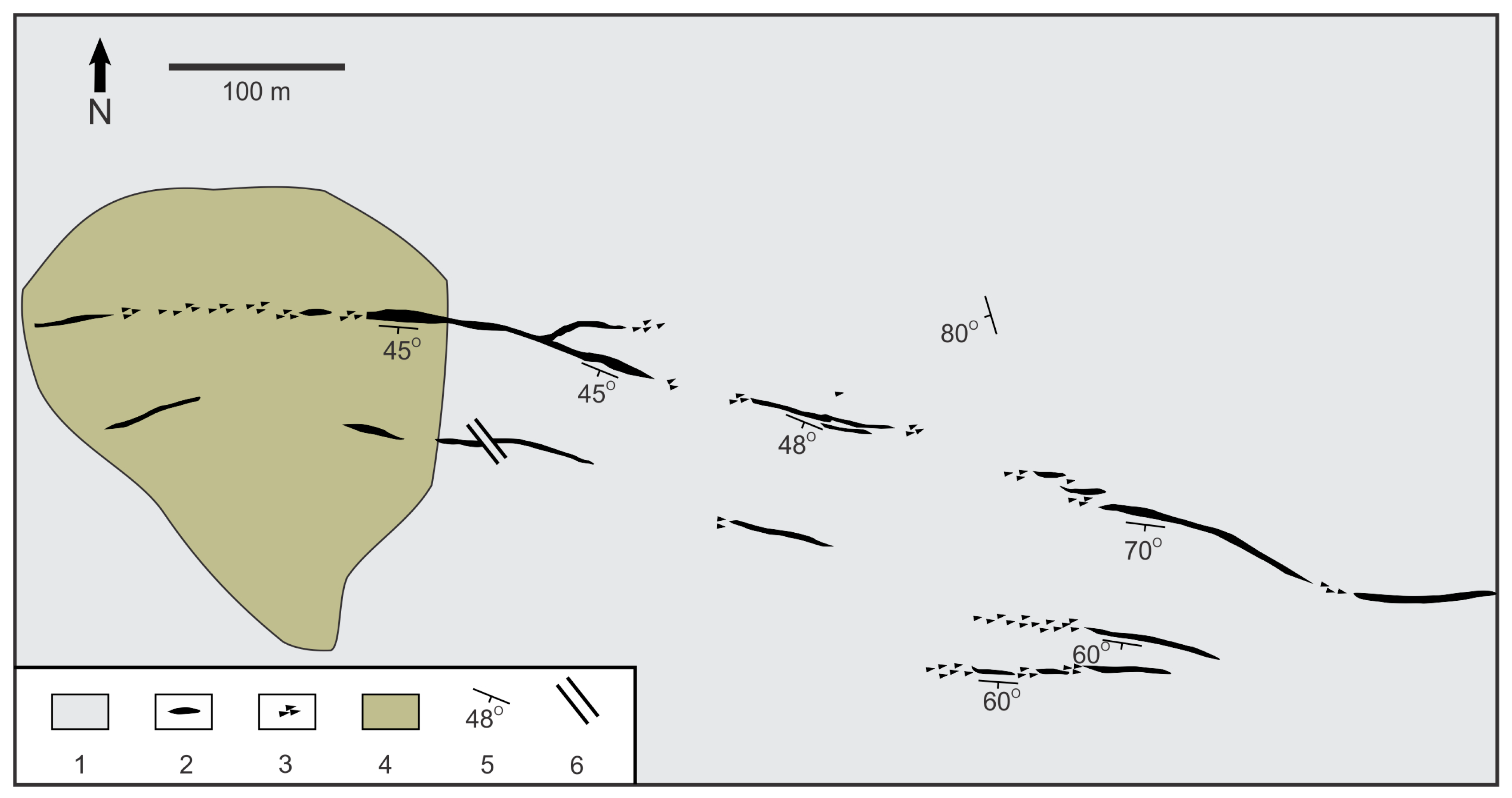
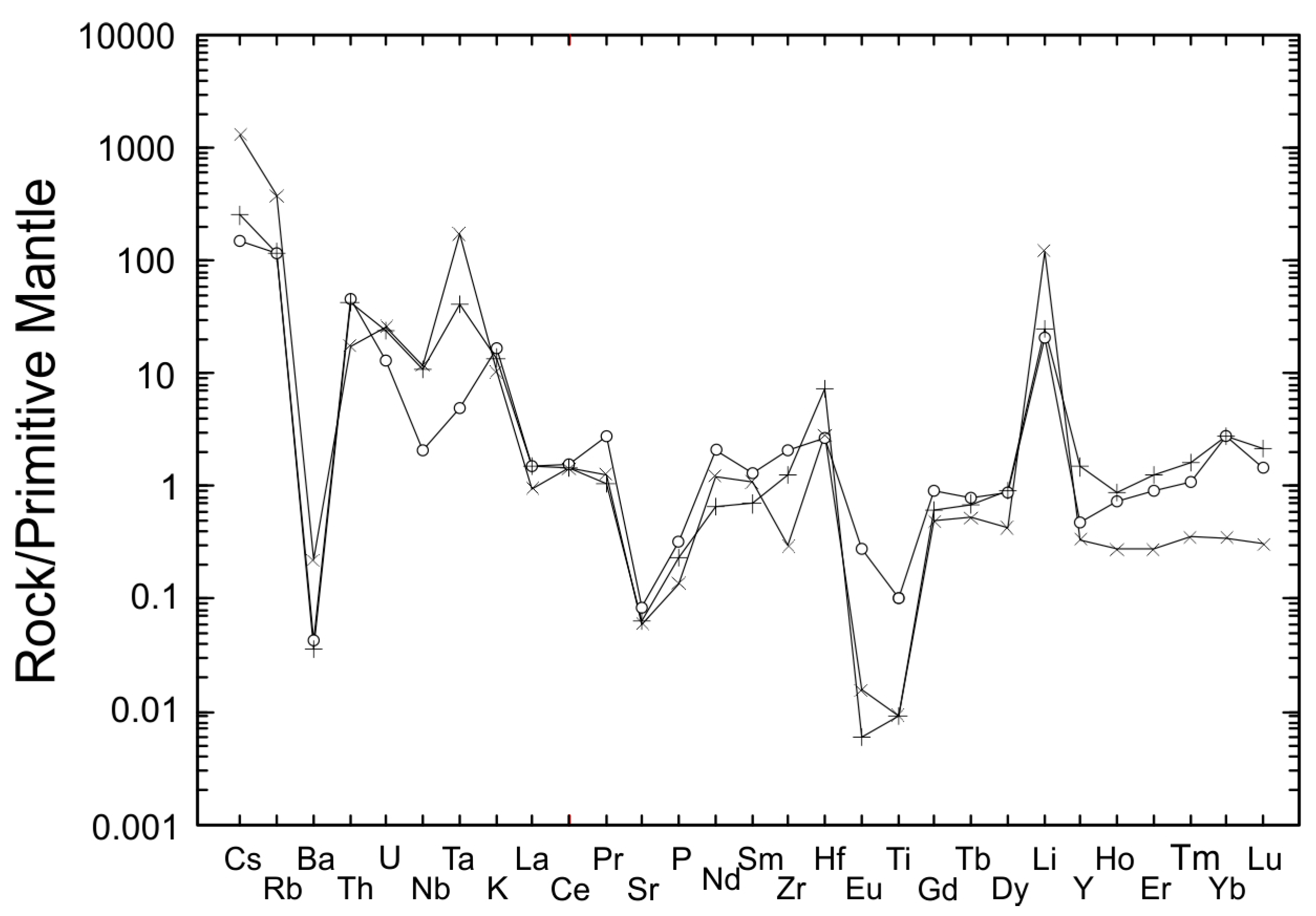
| Name | Formula | Li2O (wt.%) * |
|---|---|---|
| Eucryptite | LiAlSiO4 | 11.86 |
| Spodumene | LiAl (Si2O6) | 8.03 |
| Petalite | LiAl (Si4O10) | 4.88 |
| Lepidolite | K(Li,Al)3(Si,Al)4O10(OH,F)2 | 7.70 |
| Zinnwaldite | KLiFeAl(Al,Si3)O10(OH,F)2 | 4.12 |
| Triphylite | Li(Fe,Mn)PO4 | 9.47 |
| Amblygonite | LiAl(PO4)F | 10.10 |
| Montebrasite | LiAl(PO4)OH | 10.10 |
| Jadarite | LiNaSiB3O7(OH) | 7.30 |
| Hectorite | Na0.3(Mg,Li)3(Si4O10)(F,OH)2x nH2O |
| Pegmatite 1–6 | |||
| 1 | Khukh Del Uul | N 46°00′ | E 108°49′ |
| 2 | Munkhiin Tsagaan Durvuljin | N 45°53′ | E 108°22′ |
| 3 | Berkh | N 47°46′ | E 111°11′ |
| 4 | Unjuul | N 47°19′ | E 105°03′ |
| 5 | Bayan Teeg | N 45°16′ | E 107°07′ |
| 6 | Baga, Ikh Yamaat | N 49°46′ | E 97°06′ |
| Granite 7–13 | |||
| 7 | Janchivlan | N47°35′ | E 107°34′ |
| 8 | Urt Gozgor | N 47°34′ | E 107°32′ |
| 9 | Baga Gazar | N 46°15′ | E 105°56′ |
| 10 | Avdar | N 47°37′ | E 105°27′ |
| 11 | Arbayn | N 46°03′ | E 115°47′ |
| 12 | Uizen | N 46°03′ | E 110°38′ |
| 13 | Bor Khujir | N 46°33′ | E 109°14′ |
| Ongonite 14–15 Ongonite; Ongorhyolite | |||
| 14 | Ongon Khairkhan | N 47°04′ | E 105°10′ |
| 15 | Teeg Uul | N 44°19′ | E 105°10′ |
| Li sediments 16 | |||
| 16 | Khukh Del | N 45° 07′ | E 106°52′ |
| Li brines 17–23 | |||
| Eastern Mongolia | |||
| 17 | Dund Bayan nuur | N 46°26′ | E 114°07′ |
| 18 | Baruun Davst nuur | N 48°20′ | E 114°35′ |
| 19 | Baavhai Uul | N 45°17′ | E 113°49′ |
| 20 | Urgakh Naaran | N 45°50′ | E 112°20′ |
| Western Mongolia | |||
| 21 | Uvs nuur | N 50°23′ | E 92°41′ |
| 22 | Khyargas nuur | N 49°11′ | E 93°16′ |
| 23 | Dergen nuur | N 46°13′ | E 93°27′ |
| wt.% | JA-1 | JA-4 | JA-7 | JA-9 | ONG | Avdar-1 | Avdar-2 | Baga-1 | Baga-2 | Baga-Gr |
|---|---|---|---|---|---|---|---|---|---|---|
| SiO2 | 73.04 | 76.1 | 75.8 | 70.9 | 70.84 | 72.33 | 75.84 | 76.03 | 77.02 | 80.23 |
| TiO2 | 0.215 | 0.061 | 0.014 | 0.004 | 0.02 | 0.22 | 0.02 | 0.12 | 0.10 | 0.11 |
| Al2O3 | 13.52 | 12.22 | 12.78 | 17.65 | 16.65 | 13.48 | 12.76 | 12.58 | 9.75 | 9.58 |
| Fe2O3(t) | 1.61 | 1.03 | 0.79 | 0.12 | 0.24 | 2.82 | 1.73 | 1.42 | 1.85 | 4.66 |
| MnO | 0.044 | 0.033 | 0.024 | 0.034 | 0.17 | 0.04 | 0.04 | 0.03 | 0.03 | 0.10 |
| MgO | 0.27 | 0.03 | 0.01 | 0.01 | 0.03 | 0.64 | 0.13 | 0.04 | 0.30 | 0.05 |
| CaO | 0.97 | 0.44 | 0.26 | 0.12 | 0.17 | 1.28 | 0.32 | 0.55 | 0.40 | 0.88 |
| Na2O | 3.23 | 3.49 | 4.29 | 5.85 | 5.90 | 4.21 | 4.46 | 3.39 | 3.28 | 0.10 |
| K2O | 4.90 | 4.60 | 4.03 | 3.22 | 3.14 | 4.97 | 4.14 | 4.81 | 4.63 | 2.03 |
| P2O5 | 0.10 | 0.01 | 0.01 | 0.01 | 0.03 | 0.07 | 0.05 | 0.03 | 0.04 | 0.04 |
| LOI | 0.77 | 0.52 | 0.49 | 0.86 | 1.40 | 0.46 | 0.43 | 0.65 | 0.64 | 1.57 |
| Total | 98.669 | 98.534 | 98.498 | 98.778 | 98.59 | 100.52 | 99.92 | 99.65 | 98.04 | 99.34 |
| ppm | ||||||||||
| Li | 165 | 352 | 859 | 389 | 1950 | 338 | 396 | 156 | 158 | 856 |
| Cs | 12.7 | 24.5 | 15.2 | 10.1 | 104 | 12 | 20 | 15 | 15 | 36 |
| Rb | 265 | 627 | 751 | 1250 | 2404 | 730 | 753 | 429 | 525 | 556 |
| Ba | 384 | 61 | 1 | 5 | 15.5 | 3 | 2.5 | 78 | 27 | 53.4 |
| Sr | 115 | 15 | 2 | 6 | 12.7 | 17.9 | 13.6 | 31 | 23 | 24.7 |
| Ta | 2.97 | 6.17 | 5.93 | 22.6 | 71.1 | 2.0 | 17.1 | 5.4 | 6.8 | 8.9 |
| Nb | 8.8 | 35.6 | 22 | 56.8 | 83.8 | 15 | 78 | 40 | 47 | 93.5 |
| Hf | 3.2 | 7.1 | 8.9 | 6.4 | 9.0 | 8.3 | 22 | 8 | 9 | 7.6 |
| Zr | 111 | 143 | 83 | 18 | 33.0 | 230 | 140 | 163 | 165 | 160 |
| Y | 18.4 | 94.7 | 164 | 1 | 15.4 | 21.8 | 67.4 | 82 | 130 | 87.3 |
| Th | 15.1 | 49 | 30.5 | 20.8 | 15.0 | 38.4 | 36.4 | 40 | 56 | 38 |
| U | 6.95 | 4.94 | 4.41 | 4.13 | 5.48 | 2.7 | 5.1 | 9.7 | 4.8 | 8.36 |
| La | 23.6 | 57.3 | 22.6 | 2.43 | 6.59 | 10.3 | 10.3 | 31.27 | 33 | 36.84 |
| Ce | 49.2 | 106 | 68.2 | 7.61 | 25.47 | 27.7 | 25.5 | 73.97 | 79 | 86.59 |
| Pr | 5.68 | 11.6 | 9.77 | 1.13 | 3.51 | 7.8 | 2.9 | 9.39 | 10 | 10.85 |
| Nd | 21.1 | 38.0 | 39.0 | 2.67 | 16.7 | 28.5 | 9.0 | 35.18 | 37 | 40.29 |
| Sm | 4.30 | 8.64 | 14.4 | 0.73 | 4.86 | 5.9 | 3.1 | 9.27 | 10.7 | 10.14 |
| Eu | 0.52 | 0.207 | 0.007 | 0.025 | 0.03 | 0.46 | 0.01 | 0.17 | 0.10 | 0.20 |
| Gd | 3.55 | 7.95 | 14.9 | 0.32 | 2.93 | 5.4 | 3.6 | 9.91 | 12.1 | 10.4 |
| Tb | 0.58 | 1.72 | 3.55 | 0.10 | 0.57 | 0.86 | 0.75 | 1.93 | 2.51 | 2.02 |
| Dy | 3.42 | 12.9 | 26.5 | 0.77 | 3.16 | 6.5 | 6.7 | 13.74 | 18.7 | 14.36 |
| Ho | 0.62 | 2.88 | 5.74 | 0.16 | 0.45 | 1.21 | 1.43 | 3.03 | 4.27 | 3.15 |
| Er | 1.9 | 9.73 | 19.3 | 0.59 | 1.32 | 4.4 | 6.0 | 10.26 | 14.8 | 10.54 |
| Tm | 0.276 | 1.64 | 3.43 | 0.173 | 0.26 | 0.82 | 1.2 | 1.66 | 2.52 | 1.72 |
| Yb | 1.86 | 11.9 | 24.4 | 1.64 | 1.73 | 13.8 | 13.7 | 11.58 | 18.0 | 11.9 |
| Lu | 0.287 | 1.81 | 3.69 | 0.288 | 0.23 | 1.08 | 1.62 | 1.73 | 2.69 | 1.80 |
| F | 8400 | 2800 | 3100 | 3900 | 4300 | 24,739 |
Disclaimer/Publisher’s Note: The statements, opinions and data contained in all publications are solely those of the individual author(s) and contributor(s) and not of MDPI and/or the editor(s). MDPI and/or the editor(s) disclaim responsibility for any injury to people or property resulting from any ideas, methods, instructions or products referred to in the content. |
© 2024 by the authors. Licensee MDPI, Basel, Switzerland. This article is an open access article distributed under the terms and conditions of the Creative Commons Attribution (CC BY) license (https://creativecommons.org/licenses/by/4.0/).
Share and Cite
Dostal, J.; Gerel, O. Characteristics of Lithium Deposits in Mongolia. Minerals 2024, 14, 960. https://doi.org/10.3390/min14100960
Dostal J, Gerel O. Characteristics of Lithium Deposits in Mongolia. Minerals. 2024; 14(10):960. https://doi.org/10.3390/min14100960
Chicago/Turabian StyleDostal, Jaroslav, and Ochir Gerel. 2024. "Characteristics of Lithium Deposits in Mongolia" Minerals 14, no. 10: 960. https://doi.org/10.3390/min14100960
APA StyleDostal, J., & Gerel, O. (2024). Characteristics of Lithium Deposits in Mongolia. Minerals, 14(10), 960. https://doi.org/10.3390/min14100960







